The Polish elite entertained themselves in an envelope of glitz, enjoying champagne from crystal glasses at a lavishly set table. Ordinary citizens dreamed of experiencing similar madness for a while and did it ... according to their own wallet. But with a class you can only dream of today.
Although their financial possibilities were limited, ordinary Poles wanted to have fun after regaining independence. It is true that they could not join the representatives of the diplomatic corps at the presidential banquet, but no one could forbid them from organizing parties at their own home. Of course, it was connected with expenses, some inconveniences and a whole lot of work for the hostess, but nevertheless inviting guests for a small lunch, dancing tea or an elegant dinner was simply fashionable.
Both well-to-do entrepreneurs and much poorer officials, shopkeepers and representatives of less profitable professions did not want to feel inferior. That is why on various occasions people had fun around the houses, organizing high life as much as possible.
How do you shine in front of your guests?
Many a housewife, whose family reached a slightly higher standard of living, dreamed of shining in her new company. It was best to do this during the party you were organizing. The whole problem was with one nagging question:how?
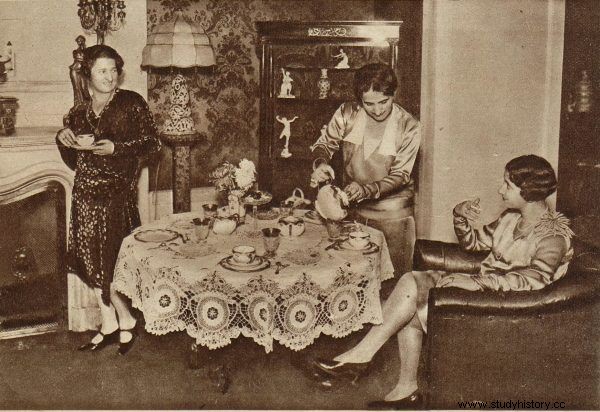
Afternoon tea, 1929. For such an occasion, the table had to be covered with porcelain and covered with an elegant tablecloth. The photo and caption come from the book "Twenty years from the kitchen".
The guides of the time provided help to such unsure housewives. The Warsaw Publishing Society "Bluszcz" in its series Życie Praktyczne has released a booklet consisting of two volumes What, when and how to serve? . It was a treasure trove of knowledge. In the introduction, the author of the first part emphasized the importance of, above all, the aesthetic impression:
And that is why it is extremely important for every housewife to be able to serve dishes in the correct form that affects the appetite by means of eyesight. Not only do you need to know how to cook dishes and dispose of them without hesitation:you also need to know what and when to serve and what form to wear. Everything should correspond not only to the time of the day it is eaten, but also to the place where it is served.
In truth, these rules have not changed to this day. It is always better, for example, to elegantly cut a piece of roast, place it on a serving plate and pour it over with the help of a sauceboat or a suitable spoon, than to sloppily throw a piece of meat straight onto a plate and sprinkle the sauce from a pot or pan. It does not seem to change the taste of the dish, but the impressions are incomparable.
Our great-grandmothers, who did not have the opportunity to learn the art of hosting guests in their family homes, had to deal differently. The higher they climbed the social ladder, the more conventions reached them. Lunch. Nowadays, one- or two-course dishes, possibly with dessert. Plus something to drink and from the head.
Meanwhile, before the war, dinners could be divided into five categories! A modest everyday dinner, a "makeshift" dinner cooked quickly on the stove after returning from work, among other duties, a daily lunch eaten later in the evening, a sumptuous evening dinner and a dinner invitation. You can get lost.
Let us note, however, that such a "daily dinner" was not very modest, and guests often appeared at it. To eat in front of the TV, with a plate in his lap, it was like a ready-made microwave hamburger for a seasoned beef burger grilled over the fire. Nothing.
First of all, an aesthetic impression
For such a meal, the table was to be covered with a white tablecloth and napkins, and guests were to have sufficiently large napkins to put on the lap. Crockery is necessarily uniform, nice and modest. Today we use it only for holidays, and on a daily basis we often eat it from mismatched plates.
In addition to the cutlery, the table had to include fresh water in a glass jug or carafe, salt shakers, a sugar bowl with fine sugar, dishes with oil, vinegar and mustard, and a basket full of fresh bread. Next to the plates, naturally a knife, fork, spoon, fork and dessert spoon. In a word, elegance.
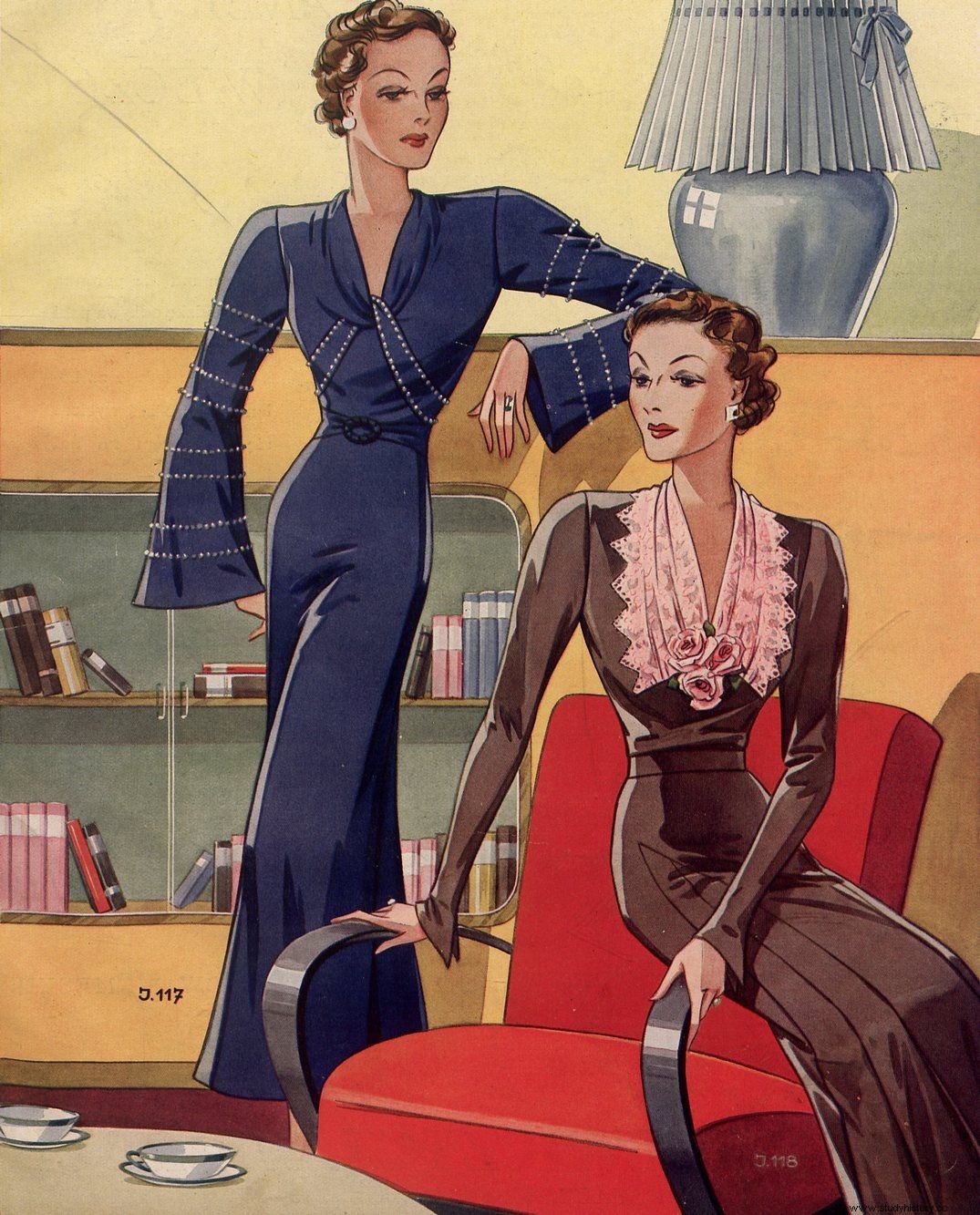
The requested meeting required an appropriate setting. Fragment of the cover of the magazine "Przegląd Mody" from 1937.
According to the authors of both parts of the guide on What, when and how to serve? , each meal should be consumed in an appropriate setting, including breakfasts (the first and the second). None of the boarders should appear in sloppy, dirty or inappropriate clothes for the time of day. Especially if there were guests at the house. The dinner parties required the greatest care.
The dinner party, served at a larger gathering, banquet or prom, has its own special rules that we must adhere to. The table, set according to all fashion requirements, is covered with white, smooth or lace-decorated table linen, set with a uniform porcelain set, skillfully and correctly placed knives and forks (...); the sophistication and decorativeness are enhanced by glass and glass crystals as well as fresh flowers and fruit.
Without a spectacular menu, don't move
Although today's nutritionists would grab their heads for such a dictum, a refined meal of the type described was usually served after 10 p.m., and if it was part of the prom, even at 1. What was eaten then? It was definitely not a light menu. In the guide, we can find an example of a dinner menu. It includes, among others, Pike perch, pate in shortcrust pastry or turkey with chestnuts. Plus, of course, salads and pickles.
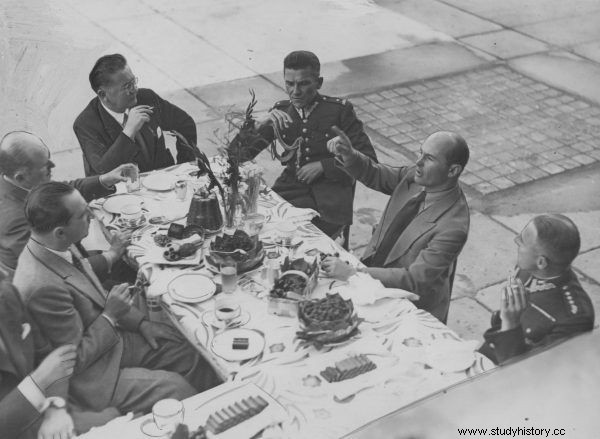
Jan Kiepura, a singer, having afternoon tea at the Officers' Yacht Club of the Republic of Poland, surrounded by high-ranking soldiers and officials. Such a meeting could not be complete without a solid meal. The photo and caption come from the book "Twenty years from the kitchen".
There was also a dessert, such as ice cream decorated with waffles or dried fruits, fruit and black coffee. Especially the legitimacy of serving the latter seems to be debatable, given the timing, but the cup of the little black cup was absolutely indispensable. Such a mountain of food could not be easily swallowed late in the evening, and strong coffee drunk at said time definitely did not make it easier to fall asleep later.
Seemingly a bit less sumptuous, but in fact requiring a lot more logistics from the hostess, were the buffet parties. During an elegant dinner, it was enough to seat guests and serve dishes, making sure that they were warm and served with the right alcohol. And yet the preparation of a decent snack, known today as the smorgasbord, forced the hostess to a real acrobatics.
Great refurbishment
First of all, it was necessary to prepare the table. It was usually placed in the dining room, but for the sake of guests and ... the nerves of the lady of the house, it was better to remove all unnecessary equipment from the room. After all, in a situation in which alcohol was involved, it is not difficult to make a minor stumble that becomes a complete catastrophe. Trinkets, antique sofas, standing lamps and other delicate items must necessarily disappear. The buffet was placed in the center of the room, while all the chairs landed against the walls so that the guests would not accidentally sit down at the table as at an old Polish feast.
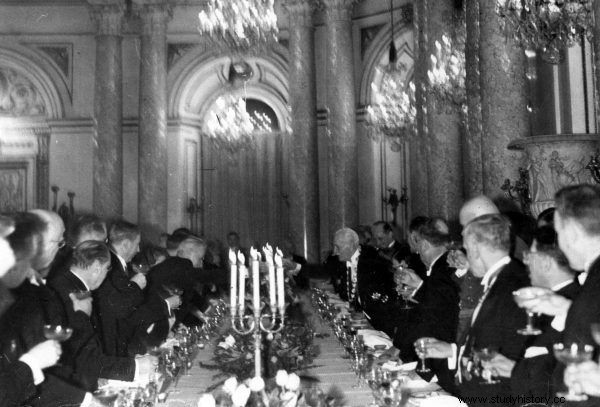
Buffet parties seem easier to organize than those at a long table. Nothing of that. The photo of the party with the participation of President Mościcki comes from the book "Twenty years from the kitchen".
The second table was needed for alcohol. Just in case, it had to be additionally secured by placing an oilcloth under the tablecloth. The longer these parties lasted, the more alcohol tended to spill at the most unsuitable moments, and the polished finish on furniture fashionable in the 1920s and 1930s was sensitive to its effects. On the table with spirits, apart from bottles containing percentages, there were also glasses, jugs with lemonade, crumble and water.
Of course, the table intended for the buffet had to be covered with a tablecloth, and at its two ends there were to be pyramids of clean plates, cutlery (depending on the menu - forks, knives, spoons and spoons) and compote plates (glass or porcelain dishes for serving compotes with fruit) and ice cream).
As decoration, the authors of What, when and how to serve? They mainly recommended candelabra with burning candles and fruit. The latter combined a pleasant aesthetic experience with a very important function - being a dessert. They could be served in baskets, on plates, in porcelain, in the shape that Mother Nature gave them, or carved in fanciful forms. Berries, like strawberries, had to be arranged in intricate pyramids and selected taking into account the season. Alternatively, if the lady of the house really wanted to shine, instead of fruit, she could serve an elegant cake, placing it in the center, in the honorary place of the buffet ..

Incredible resourcefulness, delicious dishes, unique taste. Learn about the female history of pre-war Poland in our latest book. "Twenty years from the kitchen" by Ola Zaprutko-Janicka now available for sale!
A bit of logistics
At such parties, cold dishes were served, which had its excellent justification. Regardless of whether the guests were served by the lady of the house or the maid, serving the hot dishes in each case took too much time (you had to put them at the right temperature and keep it so that they would not lose their flavor over time). various, not necessarily desirable fragrances around him.
Instead of them, the most convenient option was cold dishes, which not only was enough to put on the table once, but also the issue of keeping an eye on their temperature disappeared. Roasted meats and cold cuts were perfect, such as rump, pork loin, roast beef, poultry, game, beautifully sliced thinly and elegantly arranged.
Served on juicy green lettuce leaves, dressed with boiled eggs, pickles or vegetable jellies, or gently sprinkled with meat jelly on top, just to give them a sparkle. In addition to them, small snacks, such as canned sardines (but not herring for the sake of the smell!), Sandwiches, varied and artistically presented, salads with olive oil, vinegar or spicy or mayonnaise sauce. In addition, there was mustard and various sauces, including horseradish with cream and tartar sauce. A real treat!
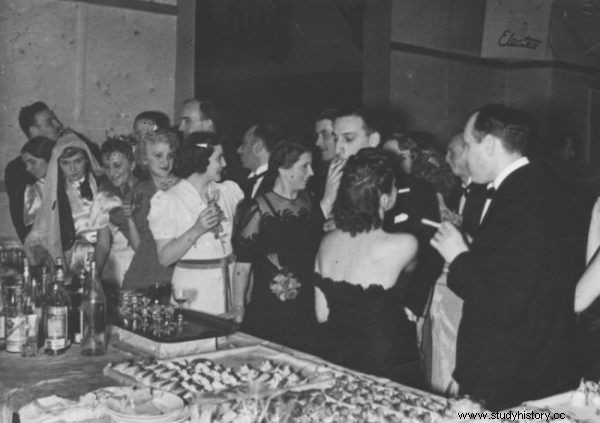
Buffet at the Ball of the Academy of Fine Arts in Warsaw.
Only one thing could not be forgotten - the dishes. Pre-prepared stacks of plates tended to disappear too quickly. It was necessary to keep an eye on collecting, taking to the kitchen and washing dirty plates, otherwise the threads from the buffet party, since the guests had nothing to eat.
***
Incredible resourcefulness, delicious dishes, unique taste. Get to know the female face of the Second Polish Republic. From the culinary side and more! Today buy your own copy our latest book: "Twenty years from the kitchen. Culinary history of pre-war Poland ”by Aleksandra Zaprutko-Janicka. Order your copy at a discount on empik.com.
Bibliography:
The article was created on the basis of materials collected for the book "Twenty years from the kitchen. Pre-war culinary history Polish ” . The author used, inter alia,:
- Janicki K., First Ladies of the Second Polish Republic , Krakow 2012.
- Jaźwiński P., Officers and gentlemen. Private and business life of cavalrymen of the Second Republic of Poland , Warsaw 2011.
- Kirkor-Kiedroniowa Z., Memories , vol. 1, Krakow 1986.
- Łozińska M., Tastes of the twenty years. Culinary customs, balls and banquets , Warsaw 2011.
- Pruszak T.A., Earthly holidays and games. Carnival, wedding, harvest festival and other traditions , Warsaw 2012.
- W.M., What, when and how to serve. Part I , Warsaw 1930.
- W.M., What, when and how to serve. Part II , Warsaw 1930.
